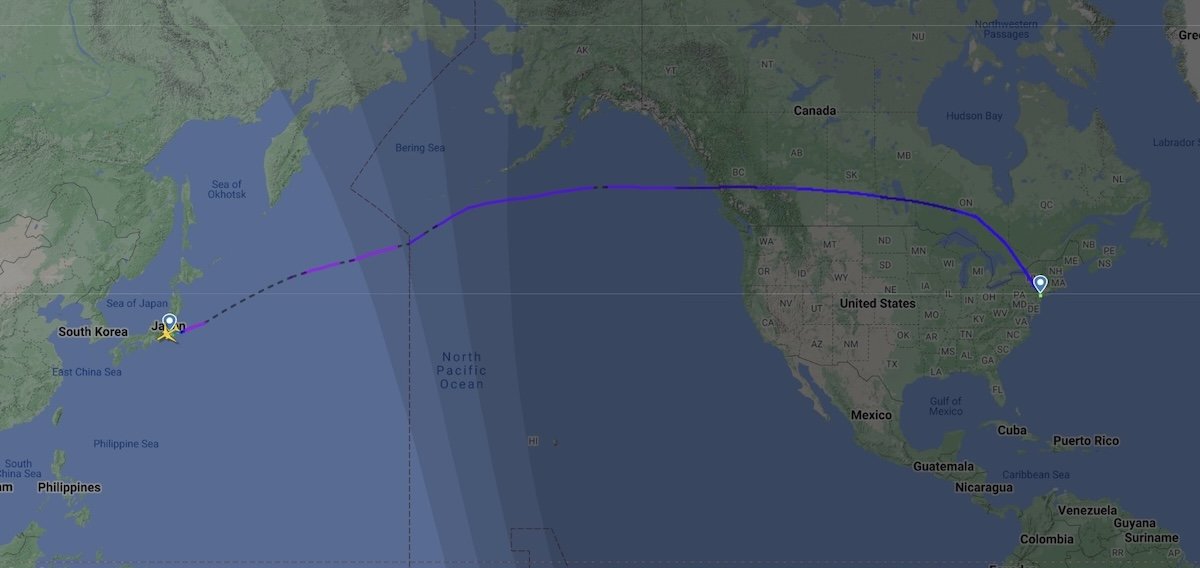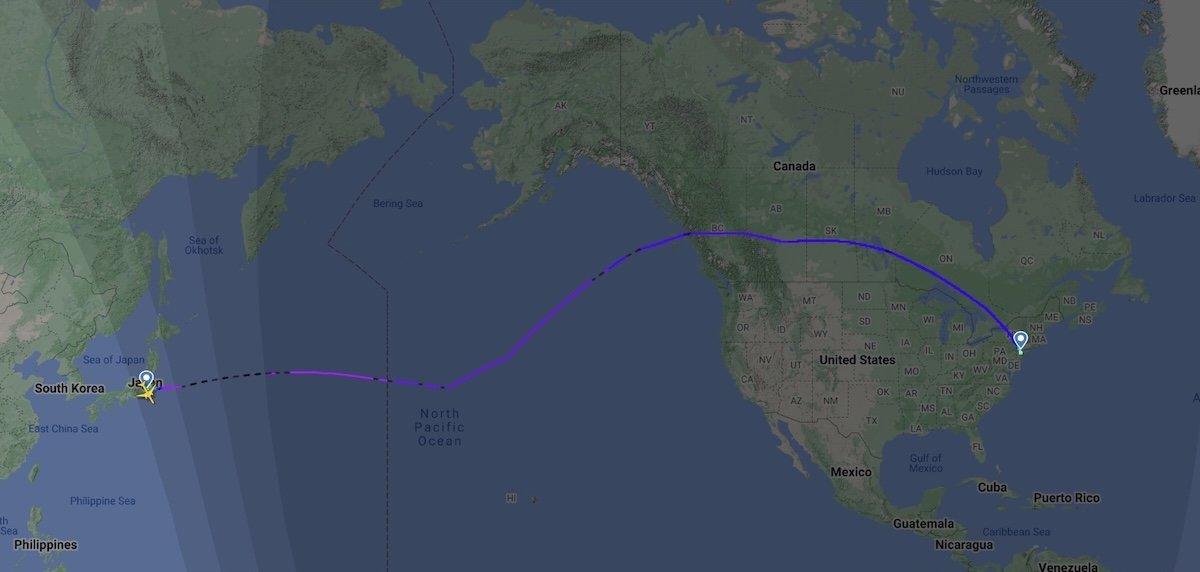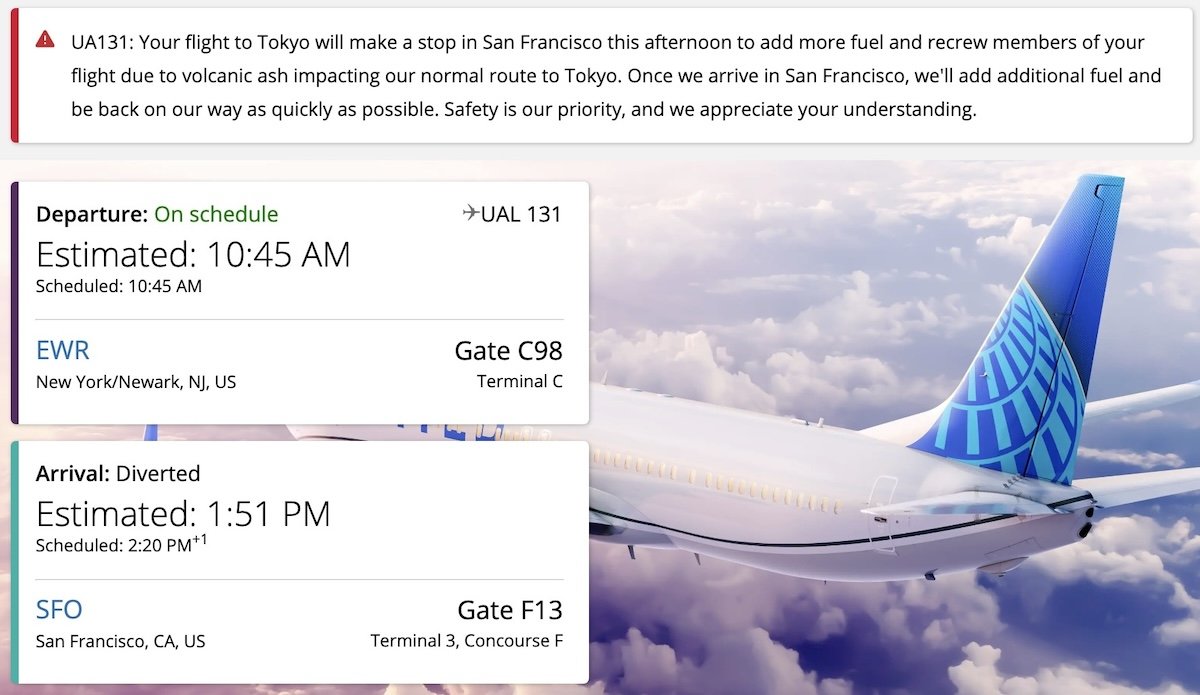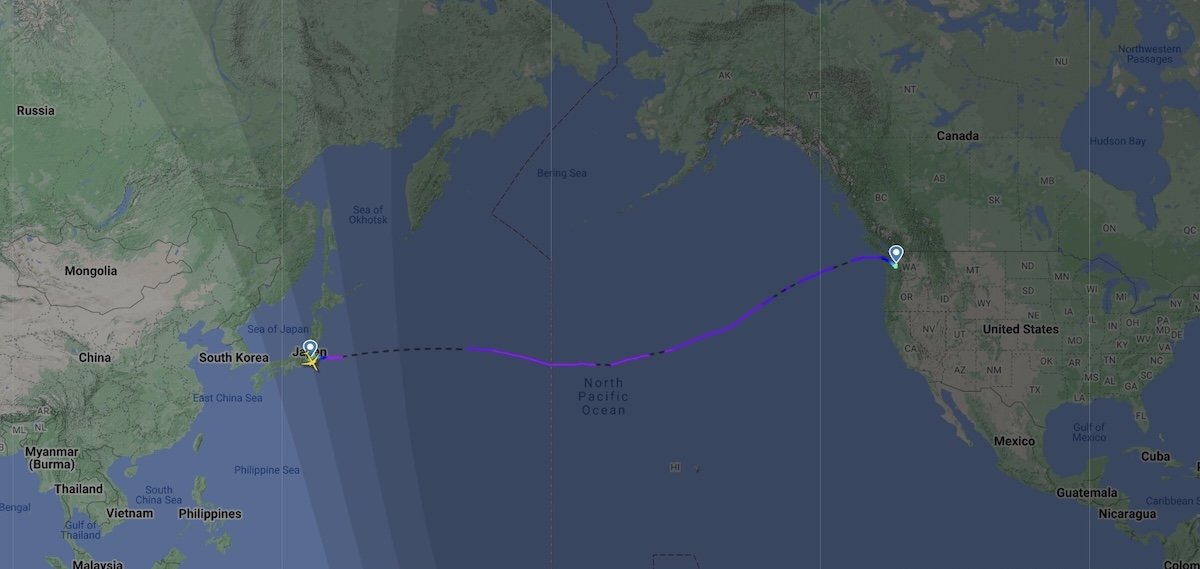The eruption of a Russian volcano is causing quite some issues for airlines this week. The problems apply to many transpacific flights, even those that avoid Russian airspace.
In this post:
Volcano erupts on Russia’s Kamchatka Peninsula
On Wednesday, November 1, 2023, Eurasia’s tallest active volcano erupted. Specifically, the Klyuchevskaya Sopka volcano is 4,650 meters tall (15,255 feet). This volcano is located on Russia’s Kamchatka Peninsula, in the northern part of the country, near the Bering Sea, which separates Russia and Alaska.
The good news is that this area is sparsely populated (there are two towns not too far away, each with around 5,000 people), and there have been no reports of injuries.
The bad news is that the impact of the volcano goes way beyond the immediate area. As you’d expect, this eruption is causing some major ash clouds, with ash being reported as high as eight miles above sea level, even higher than most commercial aircraft fly.
How the volcano eruption has impacted flights
While many airlines already avoid Russian airspace on transpacific flights (due to flight restrictions in place, plus out of an abundance of caution), the implications of these ash clouds go way beyond that. Long story short, flights that would ordinarily operate near the Bering Sea (staying just south of Russia) are needing to route much further south.
At a minimum, flights are taking materially longer than usual, especially those headed to North Asia (like Japan and South Korea). Just to give an example, let’s look at United’s flight UA131 from Newark (EWR) to Tokyo (HND). On October 31, before the volcano erupted, the flight took 14hr1min.

Then on November 2, the flight took 16hr26min, so that’s a full 2hr25min longer.

And the situation today seems to be even worse, as the plane will make a fuel stop in San Francisco (SFO).

As another example, let’s look at Delta’s flight DL167 from Seattle (SEA) to Tokyo (HND). On October 31, before the volcano erupted, the flight took 9hr59min.

Then on November 2, the flight took 12hr29min, so that’s a full 2hr30min longer.

And the situation today seems to be even worse, as the flight has just been outright canceled.

The trend here is pretty obvious. As the ash keeps getting pushed further out, the operational disruptions are becoming greater. Hopefully this trend reverses soon, but in the meantime, you can expect transpacific flights will take quite a bit longer than before. If you have any tight connections planned, you might want to plan accordingly.
Bottom line
On November 1, one of Russia’s largest volcanoes erupted. In addition to the impact on the immediate area, this is having major implications for transpacific flights, especially those that generally take northerly routings. Flights are currently taking significantly longer across the Pacific than usual. Unfortunately the situation still seems to be getting worse, rather than better.
Have any OMAAT readers been impacted by this volcanic eruption in Russia?





I remember spending a few weeks in January 2015 in Kamchatka. The mountains are simply spectacular. One of my best memories is learning dog sledding with the Koryak people. I specifically remember coming out of a trail in the woods onto a frozen lake in the evening on a sled, and seeing the Koryaksky Volcano lit up by the setting sun reflecting off the snow. It was absolutely breathtaking. I definitely recommend putting Kamchatka on your bucket list!
Looking on weather satellites and FR24's volcanic ash map, I think it might be a different volcano (Mount Shishaldin in Alaska) that is causing the disruption.
No, if you mouse over the FR24 ash map you can see that it's the ash from the Kamchatka volcano. However, business has been back to normal for the last 36 hours or so and flights are once again following the east coast of Russia between Alaska and Japan.
AA280 from ICN to DFW diverted to Los Angeles today due to needing extra fuel to go around this
This affected my Thursday morning (very early) flight out of New York to Haneda. Added a little over an hour to the flight time, making it 15 hrs 45 minutes. Don't know if this is related but the ANA 777 ran out of water for the last few hours making hand washing impossible. Fortunately the toilets still worked.
Hopefully doesn’t end up like Eyjafjallajökull in 2010.
You mean end up with nobody able to pronounce it even after all these years.
On 11/2 UA 881 from ORD to HND was operated by a 787-10. It took around 15 hours and flew 7126 miles (headwind) to reach Haneda due to the volcano. Im impressed but was this weight restricted?
The delivery flight for Delta's newest A330-900 was originally supposed to operate from Toulouse to Narita where Delta does induction work on new widebodies but operated instead from TLS to MSP where it overnighted. It is now enroute to NRT on a flight estimating at 16.5 hours.
UA's ORD-HND flight is not operating nonstop today but JL and NH's nonstops to Tokyo are operating on a northerly polar-type route and then going south from...
The delivery flight for Delta's newest A330-900 was originally supposed to operate from Toulouse to Narita where Delta does induction work on new widebodies but operated instead from TLS to MSP where it overnighted. It is now enroute to NRT on a flight estimating at 16.5 hours.
UA's ORD-HND flight is not operating nonstop today but JL and NH's nonstops to Tokyo are operating on a northerly polar-type route and then going south from the Aleutians which is similar to what KE is doing on some routes while DL and are taking more southerly routings.
Extended flight times are not the issue for most widebody aircraft; they can fly much further than they are regularly scheduled but w/ payload restrictions.
The issue is that an airline has to payload restrict so low that they create an operational disaster by having to deny boarding to a large number of passengers.
Also, most airlines cannot schedule a longhaul pilot crew to divert to an intermediate airport after an extended flight...
Extended flight times are not the issue for most widebody aircraft; they can fly much further than they are regularly scheduled but w/ payload restrictions.
The issue is that an airline has to payload restrict so low that they create an operational disaster by having to deny boarding to a large number of passengers.
Also, most airlines cannot schedule a longhaul pilot crew to divert to an intermediate airport after an extended flight and then take off again without rest. That is why the Korean airlines diverted to Japan and cancelled while Delta is cancelling; it is impossible to predict where the ash cloud will move and then get crews in position to continue the flight. And, at some point, the delays because of the extended flights add so much time that nobody connects and costs soar anyway.
As of now, most airlines are beginning to schedule normal operations tomorrow.
Just flew on JAL 11 First Class from DFW to Tokyo Haneda - our flight time of 12 hours turned into 14 hours and 20 minutes.
In this case, I was happy our flight time got extended - more time in JAL FC!
CI from jfk-tpe is making a stop today in KIX due to the volcanic ash. CI11
Just saw this earlier today.
Didn't a similar eruption closed Alaska a few months ago?
Significant increase in seismic or volcanic activity that the public should be concerned?
ICAO should be sanctioning Russia further for this global impact on aviation. This could have been averted with proper monitoring and crisis management.
Somebody took a shit into your brain?!
I think someone took a "shit into your brain", dink. Here's an excerpt from 'ICAO's Document on Governance and Non-Regulatory Enforcement' section 5.7 'Non-Limitations'"
"National governments, or the body to which the function has been delegated, assume full responsibility for natural occurrences and abnormalities and are not exempted for sanctions as directed from the ICAO Council".
Guess you didn't know that... let me also offer an excerpt from my personal manifesto... "YOU'RE A FUCKING IDIOT".
I think someone took a "shit into your brain", dink. Here's an excerpt from 'ICAO's Document on Governance and Non-Regulatory Enforcement' section 5.7 'Non-Limitations'"
"National governments, or the body to which the function has been delegated, assume full responsibility for natural occurrences and abnormalities and are not exempted for sanctions as directed from the ICAO Council".
Guess you didn't know that... let me also offer an excerpt from my personal manifesto... "YOU'RE A FUCKING IDIOT".
I guess you’re American as you can’t understand sarcasm
Flying SFO-HND in two weeks. Let's hope that volcano calms down before then!
What is making it worse is the jetstream ripping across the Pacific at 160-180kts
Fun fact, only US and European passenger airlines are impacted by this. Cargo airlines and passenger airlines from other countries/areas are just flying further north to avoid the issue (deeper into Russian airspace).
Not true. For example, China Eastern flight 589 from Shanghai to San Francisco also took quite southerly route today. However, flight duration is not so much different from normal flights.
There are many Non-US and Non-European passenger airlines that are not overflying Russia atm and are impacted. KE94 (IAD-ICN) diverted to NRT for fuel. AC9/10 (YYZ-NRT) are delayed. All the CX cargo flights through ANC are delayed. Also... which European passenger airline is impacted by this?
how about jl43, 45, london and paris flights... they are the worst affected
I see that the NRT-SIN on SQ11 got diverted back to NRT, do you think it has anything to do with this? The LAX-NRT part that flew earlier did not have a longer flight time than ususal tho.
It also affected the flights from Japan (and to some degree Korea) to Europe, which nowadays usually take a polar route, because of the closure of the Russian airspace. However, yesterday and today virtually all of them took a route over central Asia, leading to about 2 hours delay even when departing ontime. The only exception seems to be LH715 which still took the polar route ... I wonder if LH had different information or...
It also affected the flights from Japan (and to some degree Korea) to Europe, which nowadays usually take a polar route, because of the closure of the Russian airspace. However, yesterday and today virtually all of them took a route over central Asia, leading to about 2 hours delay even when departing ontime. The only exception seems to be LH715 which still took the polar route ... I wonder if LH had different information or just a higher risk tolerance than all the other airlines (including BA, AF, JL, NH, KE, AY etc.).
My ATL-MSP-HND flight for today got cancelled , and Delta originally rebooked the flight automatically through Honolulu, until that was cancelled…ended up shifting a day, going through Chicago on United. Of course all of my well thought out seat selections went out the window, and am ending up in middle seats …but, I won’t be missing meetings which is the reason for this trip!
When speaking with the Platinum desk last night after the cancellation...
My ATL-MSP-HND flight for today got cancelled , and Delta originally rebooked the flight automatically through Honolulu, until that was cancelled…ended up shifting a day, going through Chicago on United. Of course all of my well thought out seat selections went out the window, and am ending up in middle seats …but, I won’t be missing meetings which is the reason for this trip!
When speaking with the Platinum desk last night after the cancellation she threw out the idea of routing through Paris instead from Atlanta…shot that one down, that is a while separate can of worms that have nothing to do with volcanic ash!!
What's wrong with Paris?
Two hour transit at CDG? No thanks! And in the likely event that the flight gets cancelled while during transit, hanging out in limbo at CDG is equally unappealing!
United 881 ORD-HND yesterday took a similar southerly routing which took over 15 hours, very impressive on the 787-10. Not sure how much they had to payload restrict but 15 1/2 hours and 7100 flown miles is not shabby.
Asiana, Delta and Korean have all had to divert or cancel flights to/from S. Korea which is already long because of Russia airspace restrictions before factoring in the volcano issues. Asiana and Delta both have...
United 881 ORD-HND yesterday took a similar southerly routing which took over 15 hours, very impressive on the 787-10. Not sure how much they had to payload restrict but 15 1/2 hours and 7100 flown miles is not shabby.
Asiana, Delta and Korean have all had to divert or cancel flights to/from S. Korea which is already long because of Russia airspace restrictions before factoring in the volcano issues. Asiana and Delta both have relatively few of the most capable A350-900s so are struggling to adapt to these lengthened flight times. KE's A380s and 748s are doing better but still would require 17 1/2 hour to 18 hour flights if they didn't divert.
and there is storm activity including off the coast of Washington state so a southerly routing out of the Pacific Northwest is challenging.
Wow 787-10 15 hours pretty impressive for a plane that its range limited to 6,400 nm
I think photo of UA131 routing on October 31 is actually the routing on November 2 as the route is more diverting from ordinary routes. DL routing photos seems to be correct.
I was going to point that out too.
I think you've got the images for the United flight the wrong way round
@ Cajmo -- Fixed, thanks!